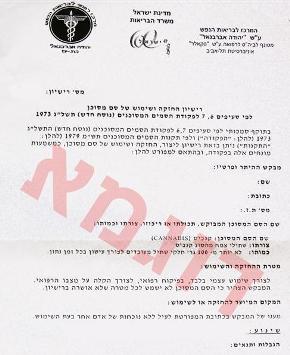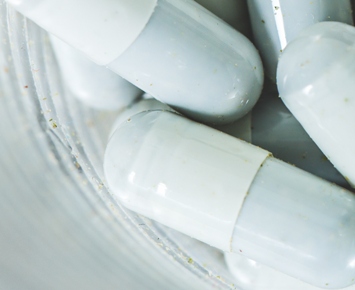The Ministry of Health in Israel has given oncologists in most of the major hospitals in the country the authority to issue medical cannabis licenses. Other doctors are expected to receive similar authority in the future. For all other medical departments, physicians may provide a written recommendation for a medical cannabis license which is sent to the Ministry of Health for approval. All specialist physicians may recommend that a medical cannabis license be issued for one of his/her patients.


The Medical Cannabis Unit of the Israel Ministry of Health handles all non-Oncology related requests for medical cannabis licenses.
Physicians must submit recommendations using the form available from the Medical Cannabis Unit of the Ministry of Health available here:
http://www.health.gov.il/Services/Citizen_Services/Pages/kanabis.aspx
Instructions on how to submit recommendations are available at the link above.
· If the specialist doctor decides that medical cannabis is appropriate for the patient. Both the doctor and the patient are required to fill out the request to the Ministry of Health.
· Patients and doctors may request Tikun Olam as the preferred supplier on the form under “supplier name”.
· It is recommended that the patient fax the completed form to the Ministry of Health directly. The fax number for submissions is: +972 2 647 4810. After submission, call +972 8 626 8000 to verify that it was received.
· Approval for a medical cannabis license takes about thirty business days and is subject to the discretion of the Ministry of Health. If the request is denied, the recommending doctor will receive an explanation for the denial. If the request is approved, the license is automatically forwarded to an assigned provider who then contacts the patient and provides the treatment.
· New indications are being added regularly, see the Ministry of Health website for up-to-date information. A physician is entitled to petition the indications committee of the Ministry of Health to add a new indication to the list. Also, physicians may request individual exceptions for patients with diseases not currently in the list, but which the physician feels warrant cannabis for the patient.
Method of Consumption:
The method of consumption: smoking, vaporizing, oil, capsule, or cookie has a determining effect on the way the treatment will affect symptoms. The methods differ in the dose required, the amount of time it takes to feel the effects of the treatment and the amount of time the effects last. Tikun Olam recommends receiving counseling and instructions from a trained doctor or nurse. It is important to note that smoking damages one’s health and alternatives are recommended.
Professional counseling is very important for correct and efficient treatment and supervision and guidance on recommended strains, dosage (initial doses and gradual increase), potential side effects, and more. During a counseling session, the patient takes the product for the first time under the supervision and guidance of an experienced registered nurse. Patients should be seated when consuming cannabis. The treatment should be consumed three times a day (morning, afternoon, evening) and the patient should drink something sweet or eat something during use. The first few times treatment is consumed, the patient should be with a friend or family member that the patient feels comfortable with.
Cannabis treatment doesn’t always have an immediate effect on symptoms. Sometimes it can take one to two months of dose adjustments until the optimal dose is reached and the full effects of the treatment are felt.
Dose:
In the absence of other instructions, general guidelines for smoking or vaporizing are: inhale two or three times (each inhalation should be brief and followed by a deep breath in and out of the lungs) and wait several minutes for the cannabis to take effect. If the effect is sufficient, this is the dose. If the effect is insufficient, inhale two or three additional times (based on the feeling) and wait (repeat as necessary until reaching the desired dose). Do not mix with tobacco!
If swallowed or dissolved in the mouth or absorbed under the tongue, take a small quantity (based on the level of active ingredients in the product) and wait two hours to feel the effects. If the effect is sufficient, this is the dose. If the effect is insufficient, take another small amount and wait (repeat as necessary until reaching the desired dose). When cannabis is consumed by swallowing or absorption, proceed slowly and cautiously until the optimal dose is reached. Consumption with fatty and/or sweet food hastens and improves the absorption in the body. Once the optimal dose is achieved, wait six hours before taking another dose. The appropriate dose for each patient is determined by taking into consideration any medications the patient is on, their weight and energy level, the symptoms they have and their intensity, and according to the consumption methods and strains that are combined. During the first few weeks of treatment, the dose can increase slowly until the optimal amount is found.
When should the product not be used?
• Do not use when pregnant or nursing.
• Not for use if a sensitivity is known to any of the ingredients.
• Not for use if there is a personal or family history of schizophrenia or other mental illness, except depression.
• The product is not recommended for people with heart problems.
The use of this product is allowed only under license of the Ministry of Health.
Warnings:
Avoid pregnancy during the course of treatment and keep away from children. Patients should be seated while consuming the product. Changes in blood pressure and pulse rate are possible, as well as, blood sugar levels.
If the patient is currently taking medication for blood pressure, pulse or sugar, monitor changes as follows:
Check blood pressure, pulse, and blood sugar levels three times a day over the course of the first three days of use. If there are significant changes advise the patient to consult with a physician in order to find the right treatment plan.
Patients with a history of epilepsy are advised to take caution.
Do not consume with alcohol! Consuming this product with alcohol can cause a cumulative decrease in coordination, concentration, and ability to react.
Patients with a tendency for addiction can also become addicted to this product.
Warning! Extreme caution should be used in treating children. Cannabis for pediatric patients is mostly given as a supportive treatment for cancer to alleviate nausea and pain and for epileptic patients. The family should receive guidelines on initial dose and gradual increase in dosage from the treating physician.
Warning! If the patient shows signs of confusion, severe restlessness, a change in consciousness, has a psychotic episode, or has a prolonged panic attack, stop taking the product immediately.
Warning! Do not take two doses simultaneously to make up for a missed dose.
Attention! The use of cannabis may impair alertness, and therefore caution should be exercised when engaging in activities such as driving a car, operating dangerous machinery, and any other activity which requires alertness. For more information please contact the Ministry of Health directly.
Drug Interactions:
There is a cumulative effect for cannabis in conjunction with opiates, alcohol, and sleep medications, take caution. If there is a need to use cannabis in conjunction with opiates or relaxers / sleep medication, significantly reduce the dose of the medications.
Hallucinations are possible when cannabis is taken in conjunction with SSRI anti-depressants. Significantly reduce the dose of the medication or the cannabis.
Because of the first-pass effect that happens to cannabinoids in the liver (especially when consumed orally), there is a theoretical risk in mixing cannabis with medications that are metabolized by the enzymes CYP3A4 and CYP2C9 in the cytochrome. If combining with medications that inhibit these enzymes such as: macrolides (especially clarithromycin and erythromycin), antimycotics (such as ketoconazole, fluconazole, itraconazole, and miconazole), calcium antagonists (especially diltiazem and verapamil), HIV protease inhibitors (especially ritonavir), isoniazid and amiodarone, be aware of side effects and reduce daily cannabis dose. The combination of cannabis and these medications can increase the biological availability of the cannabis and thus also increase its side effects.
Medications that inhibit the metabolism of cannabis through the enzymes mentioned above are: carbamazepine, rifampicin, troglitazone, rifabutin, primidone, phenytoin, phenobarbital and also the herbal plant Hypericum perforatum. If a patient begins treatment with these medications, there is a likelihood that an increased dose of medical cannabis will be necessary. Also, if a patient has found the appropriate dose of cannabis while taking these medications, the patient will need to reduce the dose of medical cannabis when these medications are no longer being taken.
Side Effects:
The side effects from the use of medical cannabis are not numerous and most are mild. In most cases, it is possible to treat a disease and symptoms with lower cannabis doses than the doses that generate psychotropic side effects. Cannabis may cause two categories of side effects, physiological effects such as: dizziness, irregular heartbeat (faster or slower), weakness, lower blood pressure and blood sugar levels, increased appetite, red eyes, tiredness, lack of coordination, lack of balance, and dryness in mucous membranes such as the mouth and eyes. Cognitive side effects may include: impairment to short-term memory and train of thought, as well as, an impaired perception of time and space. Regular use of large amounts (more than 5 grams per day) can lead to cognitive impairment, but this effect dissipates when use is ceased. In youth, cognitive impairment could be lasting.
Most side effects usually dissipate shortly after the patient becomes accustomed to the product. When cannabis is swallowed or dissolved in the mouth side effects could last for up to 72 hours.
Side effects that usually occur from overdose that require special attention:
Fainting, significant changes in blood pressure, in pulse, in blood sugar levels, or in respiration rates. A high dose of the product can in some cases, for people that are pre-disposed, cause a temporary psychotic attack, anxiety, delusions, or hallucinations.
It is important to note that there haven’t been long-term observations of patients that consume cannabis regularly for prolonged periods of time and the effects of cannabis on the brain are unknown.
Pharmacodynamic Properties:
Cannabinoids impact cannabinoid receptors in the body. Today, two main receptors are known, CB1 and CB2. CB1 is present mostly in the nervous system, and CB2 in the periphery, especially in the immune system and digestive system. THC binds to both of these receptors in the body. CB1 is responsible for THC’s neural properties – relaxation, pain relief (though CB2, scattered in the peripheral nerves, also contributes to pain relief), tremors, spasms, and in higher doses on psychotropic symptoms and euphoria. CB2 is responsible for the anti-inflammatory properties of cannabinoids. CBD, the main non-psychotropic cannabinoid, is active primarily on the anti-inflammatory and anti-oxidizing mechanisms.
Pharmacokinetic Properties:
Absorption: The absorption of cannabis varies based on the consumption methods. When inhaled, the cannabinoids are absorbed through the lungs to the blood stream in just a few minutes and reach a maximum concentration in the blood within 10-15 minutes. In this consumption form, the biological availability is at 40%. The absorption is heavily dependent on physiological differences among patients, the temperatures the cannabis was heated to, and the duration of the heating. Also, it is related to the gap between inhalations, the number of inhalations, the length of each inhalation, and the tolerance of the lungs. When swallowed, the cannabis is absorbed more slowly than smoking and has a larger variance from patient to patient. The maximum concentration of cannabinoids in the blood stream appear after 45 minutes to two hours (depending on the patient and whether the medication was consumed with food or without. Consumption with fatty or sweet food improves and hastens absorption). The biological availability through this intake method is about 10%, meaning just one fourth of the biological availability received through inhalation, mostly because of the first pass effect of the liver.
Dispersion: After absorption, the cannabinoids are dispersed throughout the entire body. Their concentration rises the quickest in tissues with high blood supply levels such as the brain, lungs, liver, and kidneys. Some cannabinoids accumulate in fat tissues. Cannabinoids bind strongly to plasma proteins. Their volume of dispersion is about 10 liters per kilogram of body weight.
Metabolism and discharge: In the liver, enzymes from the cytochrome family, CYP3A4 and CYP2X9 turn THC into 11-THC-hydroxy (THC-OH-11), the active metabolite, which turns into THC-carboxyl (THC-COOH) that is non-active. The half-life of THC and THC-OH-11 in the plasma is 25-36 hours. In the body, the half-life can reach up to seven days. In addition, other non-active metabolites are produced. THC metabolites are excreted in urine up to several weeks after cannabis is consumed.









































